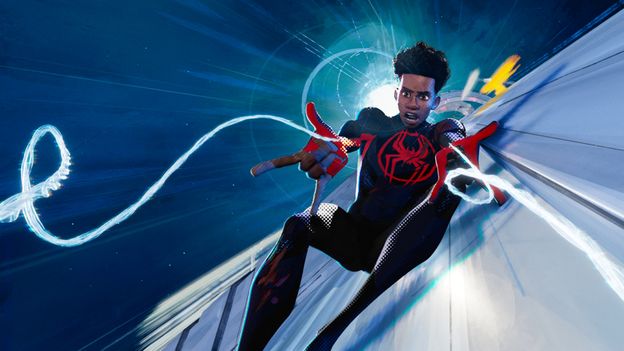New Spider-Verse is a ‘disappointment’


It feels as if a new Spider-Man film has come out every year for the past two decades, but 2018’s Spider-Man: Into the Spider-Verse somersaults over the rest of them. One of surprisingly few big-screen superhero animations, it was also the first to exploit the idea of alternate universes, and the only one to reproduce the variety of visual styles and techniques that you can see when you flip through a stack of comics. Some parts looked painted, some looked hand-drawn, some looked as if they had been printed on cheap paper, complete with the Ben-Day dots that Roy Lichtenstein put in his paintings. The film was a game-changer – a Pop-Art extravaganza that took the medium to astonishing new places. And yet, most impressively of all, the many innovations were bound up in the heartfelt story and loveable characters.
More like this:
– Five stars for Spider-Man: No Way Home
– ‘DiCaprio and De Nero are a thrill’
– A fairytale ‘for the age of Marvel movies’
The premise was that a teenager from Brooklyn, Miles Morales (voiced by Shameik Moore), became the Spider-Man of his own universe, only to discover that countless other universes had countless web-slinging, wall-climbing equivalents, including our old friend Peter Parker (Jake Johnson), Gwen Stacy (Hailee Steinfeld), a Looney Tunes-style pig called Spider-Ham (John Mulaney), and a brooding 1930s vigilante, Spider-Man Noir (Nicolas Cage), who existed in black and white. The sequel, Spider-Man: Across the Spider-Verse takes everything further. This time, Miles meets hundreds of Spider-People, such as a guitar-toting punk from London (Daniel Kaluuya) who always looks as if he is on a torn, photo-copied poster, and a preening Indian Spider-Man (Karan Soni) from a reality in which Manhattan and Mumbai are the same place. If that weren’t enough, Miles learns that these Spider-Men-and-Women have their own hi-tech headquarters where they monitor “anomalies” around the multiverse under the leadership of the gruff Spider-Man of the year 2099, Miguel O’Hara (Oscar Isaac).
As before, the cleverness and craftsmanship are so staggering that they make the directors of every other animation seem as if they aren’t trying. But perhaps Across the Spider-Verse has too much of a good thing. Co-written by its producers, Phil Lord and Christopher Miller (The Lego Movie), the film opens with a prologue revolving around Gwen’s disagreements with her policeman father (Shea Whigham), and her battle with a Vulture (Jorma Taccone) who has flapped his way into her reality from an alternate 16th Century. This section goes on for too long. Then, over in Miles’s universe, there is a sequence revolving around his disagreements with his policeman father (Brian Tyree Henry), and his battle with The Spot (Jason Schwartzman), an initially bumbling supervillain who learns how to open portals into other dimensions. This section goes on for too long, as well. Both the hyperactive fights and the po-faced speeches keep going well after you’ve got the point.
That’s not to say that Across the Spider-Verse dawdles: it crams every frame with dazzling new sights and jokes. But it feels frantically busy and wheel-spinningly slow at the same time. It’s 50 minutes before Gwen reunites with Miles, and at least another half-hour before they get to the Spider-People HQ that features so prominently in the trailers. The Spot, despite being the principal villain, is absent for much of it. But the most flagrant example of the film’s excesses is that, even though it’s nearly two-and-a-half hours long, it only gets halfway through its story. It ends on a cliffhanger, and a caption announces that Miles will return in a further instalment, Spider-Man: Beyond the Spider-Verse. No wonder it feels more exhausting than exhilarating.
Spider-geeks may not mind this self-indulgence: they are sure to spend hours rewatching and pausing it to catalogue all of the many allusions to six decades’ worth of comics, cartoons, live-action films and video games. But non-geeks may be perplexed. While Into the Spider-Verse introduced some futuristic science-fiction conceits, it was firmly rooted in the life of a troubled Brooklyn teenager, whereas Across the Spider-Verse leans into the artificiality of its world: its central, postmodern concern is how the multiverse will be affected by the tangled web of various Spider-Man narratives. If you don’t happen to be a universe-hopping comic-book superhero, it’s hard to relate to any of it.
Maybe the slight disappointment was inevitable. How could any sequel be as groundbreaking as Into the Spider-Verse was? Besides, in the four and a half years since that film came out in 2018, the concept of super-powered action in alternate universes has been explored in Spider-Man: No Way Home, Doctor Strange in the Multiverse of Madness, Teen Titans Go! vs. Teen Titans, and the Oscar-winning Everything Everywhere All At Once, so what once seemed brain-bendingly original now seems over-familiar. But the main reason why Across the Spider-Verse doesn’t live up to its predecessor is a simple one: it doesn’t have Spider-Ham in it.
★★★☆☆
Spider-Man Across the Spider-Verse is on general release from 2 June
Love film and TV? Join BBC Culture Film and TV Club on Facebook, a community for cinephiles all over the world.
If you would like to comment on this story or anything else you have seen on BBC Culture, head over to our Facebook page or message us on Twitter.
And if you liked this story, sign up for the weekly bbc.com features newsletter, called The Essential List. A handpicked selection of stories from BBC Future, Culture, Worklife and Travel, delivered to your inbox every Friday.








